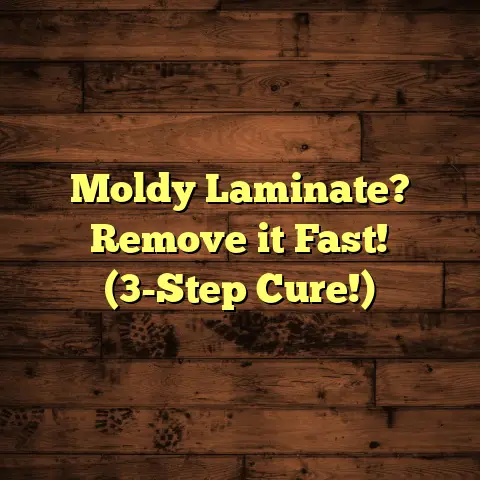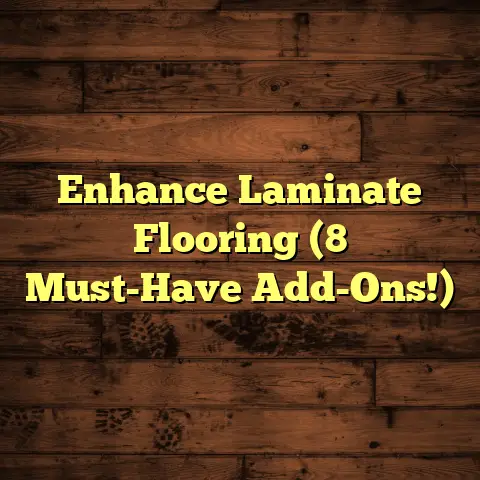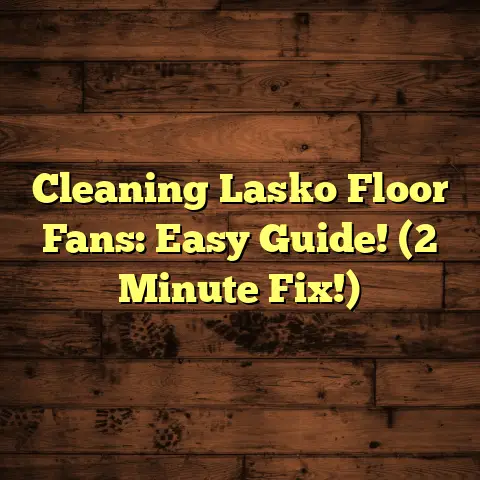Water Resistant Laminate Ok For Kitchen? (2 Must Knows!)
The kitchen. Ah, the heart of the home! I bet, like me, you can picture it now: the smell of freshly baked cookies wafting through the air, kids doing homework at the counter while you’re prepping dinner, and maybe even a spilled glass of juice (or wine – no judgment!). It’s a space filled with love, laughter, and, let’s be honest, a whole lot of potential for messes.
That’s why choosing the right flooring is so crucial. It’s not just about looks; it’s about creating a foundation for all those memories, a surface that can handle the daily grind (and spills!). You want something beautiful, durable, and, most importantly, something that won’t buckle under the pressure of a busy kitchen.
Laminate flooring has come a long way, folks. It’s no longer the flimsy stuff of yesteryear. Water-resistant laminate is making waves, and many homeowners are wondering if it’s the answer to their kitchen flooring prayers.
Well, that’s exactly what I’m here to unpack for you. As a flooring contractor with years of experience under my belt, I’ve seen it all. And I’m going to give you the inside scoop on water-resistant laminate, breaking down the pros, the cons, and the two must-know factors before you even think about installing it in your kitchen.
Ready to dive in? Let’s get to it!
Section 1: Understanding Water-Resistant Laminate
So, what exactly is water-resistant laminate? And how does it differ from the laminate flooring you might remember from your grandma’s house?
Definition and Composition
Water-resistant laminate isn’t your standard laminate. It’s engineered with a special construction designed to repel moisture. Think of it as laminate’s tougher, more resilient cousin.
The core of water-resistant laminate is usually a high-density fiberboard (HDF) or sometimes a wood plastic composite (WPC).
This core is denser than traditional laminate cores, making it less susceptible to water absorption. On top of that core, you’ll find the decorative layer – the part that gives the flooring its beautiful wood-like appearance.
This layer is actually a high-resolution image of real wood, which is then protected by a clear wear layer.
The real magic happens with the water-resistant treatment. The edges of the planks are often sealed to prevent water from seeping in between them. Some manufacturers even use a special coating on the surface to further enhance water resistance.
Think of it like a raincoat for your floor!
Here’s a quick breakdown of the layers:
- Wear Layer: A clear, durable top layer that protects against scratches, stains, and fading.
- Decorative Layer: A high-resolution image of wood, stone, or tile.
- Core Layer: The heart of the laminate, usually made of high-density fiberboard (HDF) or wood plastic composite (WPC).
- Backing Layer: Provides stability and helps prevent moisture from rising from the subfloor.
Benefits of Water-Resistant Laminate
Why are so many homeowners considering water-resistant laminate for their kitchens? Well, the benefits are pretty compelling:
- Durability: It can withstand the daily wear and tear of a busy kitchen, from dropped pots and pans to scuff marks from shoes.
- Ease of Maintenance: Spills are inevitable in the kitchen. Water-resistant laminate makes cleanup a breeze. Just wipe it up with a damp cloth, and you’re good to go!
- Aesthetic Appeal: With advancements in printing technology, water-resistant laminate can mimic the look of real hardwood, stone, or tile. You can get the beautiful look you want without the hefty price tag.
- Cost-Effectiveness: Compared to solid hardwood or natural stone, water-resistant laminate is generally more affordable.
- Easy Installation: Many water-resistant laminate products feature a click-lock system, making installation relatively straightforward. DIYers can often tackle this project themselves, saving on installation costs.
Common Misconceptions
Now, let’s bust a few myths about laminate flooring in kitchens. I’ve heard it all!
- “Laminate is cheap and flimsy.” Not anymore! Water-resistant laminate is engineered to be durable and long-lasting.
- “Laminate is not waterproof.” This is true. Water-resistant is not the same as waterproof. While it can handle spills and splashes, it’s not meant to be submerged in water for extended periods.
- “Laminate looks fake.” Again, technology has come a long way. High-resolution printing and textured surfaces make water-resistant laminate look incredibly realistic.
The key takeaway here is that water-resistant laminate is a viable option for kitchens, but it’s crucial to understand its limitations. It’s resistant, not invincible.
Section 2: The Kitchen Environment
Let’s face it: the kitchen is a battlefield. Spills, splashes, dropped food, constant foot traffic – it’s a tough environment for any flooring.
Kitchen Dynamics
Think about all the things your kitchen floor has to endure:
- Spills: Water, juice, sauces, coffee – you name it, it’s probably been spilled on your kitchen floor.
- Moisture: From dishwashing to cooking, kitchens are naturally humid environments.
- High Foot Traffic: The kitchen is often the most-used room in the house, leading to significant wear and tear on the flooring.
- Dropped Objects: Pots, pans, plates, utensils – accidents happen.
- Temperature Fluctuations: Cooking can cause temperature swings, which can affect certain flooring materials.
All these factors can take a toll on your kitchen floor, leading to damage, staining, and even mold growth if you’re not careful.
Importance of Choosing the Right Flooring
Choosing the right flooring for your kitchen is about more than just aesthetics. It’s about creating a safe, functional, and enjoyable space for your family.
Imagine this: You’re hosting a dinner party, and someone spills a glass of red wine on your brand-new hardwood floor. Panic sets in as you frantically try to clean it up, knowing that the stain might be permanent.
Now, imagine the same scenario with water-resistant laminate. You simply wipe it up with a damp cloth, and no harm is done.
The right flooring can:
- Enhance Safety: Prevent slips and falls, especially important if you have young children or elderly family members.
- Improve Functionality: Make cleanup easier and faster.
- Increase Home Value: A well-chosen, durable kitchen floor can boost your home’s resale value.
- Create a Welcoming Atmosphere: A beautiful and comfortable floor can make your kitchen a more inviting space for cooking, eating, and gathering with loved ones.
Real-Life Experiences
I’ve worked with countless homeowners who have installed water-resistant laminate in their kitchens, and I’ve seen firsthand the positive impact it can have.
One client, Sarah, had young children and was tired of constantly scrubbing her old tile floor. She switched to water-resistant laminate and couldn’t believe how much easier it was to clean. “It’s a lifesaver!” she told me. “I can just wipe up spills, and I don’t have to worry about staining.”
Another client, Mark, was concerned about the cost of real hardwood. He opted for water-resistant laminate that mimicked the look of his favorite wood species. “It looks amazing,” he said. “And it’s so much more affordable than hardwood. Plus, I don’t have to worry about water damage.”
Of course, there have been challenges too. Some homeowners have reported issues with water seeping in between the planks if spills aren’t cleaned up promptly. That’s why proper installation and maintenance are so crucial, which we’ll get to later.
Section 3: Must Know #1 – Performance in Moisture-Prone Areas
Okay, let’s get down to the nitty-gritty. How well does water-resistant laminate really perform in a kitchen environment where moisture is practically a constant companion?
Water Resistance Explained
Water resistance in laminate flooring refers to its ability to withstand surface moisture for a certain period without absorbing it and causing damage. It’s not the same as being waterproof, which implies complete and permanent protection against water.
How is this tested?
- NALFA (North American Laminate Flooring Association) Standards: NALFA sets standards for laminate flooring, including water resistance testing. Their tests typically involve exposing the laminate to water for a specific duration and then assessing any damage, such as swelling or warping.
- Swelling Tests: These tests measure how much the laminate expands when exposed to water. A lower swelling rate indicates better water resistance.
- Surface Water Tests: These tests evaluate how well the surface of the laminate repels water and prevents staining.
A good water-resistant laminate should be able to withstand spills and splashes for a reasonable amount of time (usually 24-72 hours) without significant damage.
However, it’s important to note that prolonged exposure to standing water can still cause problems, especially if the edges of the planks aren’t properly sealed.
Comparative Analysis
Let’s see how water-resistant laminate stacks up against other popular kitchen flooring options:
| Flooring Type | Water Resistance | Maintenance | Lifespan | Cost |
|---|---|---|---|---|
| Water-Resistant Laminate | Good | Easy | 10-25 years | Moderate |
| Tile | Excellent | Easy | 50+ years | Moderate to High |
| Vinyl (Sheet/Plank) | Excellent | Easy | 10-20 years | Moderate |
| Hardwood | Poor | Demanding | 25-100+ years | High |
| Engineered Wood | Fair to Good | Moderate | 20-50 years | Moderate to High |
- Tile: Tile is the king of water resistance. It’s virtually impervious to water damage, making it an excellent choice for kitchens. However, tile can be cold and hard underfoot, and installation can be labor-intensive and expensive.
- Vinyl: Vinyl flooring, especially sheet vinyl and luxury vinyl plank (LVP), is also highly water-resistant. It’s comfortable, durable, and relatively affordable. However, some vinyl products can look less realistic than water-resistant laminate.
- Hardwood: Hardwood is beautiful and timeless, but it’s a terrible choice for kitchens due to its susceptibility to water damage.
- Engineered Wood: Engineered wood is a better option than solid hardwood, as it’s more resistant to moisture. However, it’s still not as water-resistant as laminate, tile, or vinyl.
As you can see, water-resistant laminate offers a good balance of water resistance, maintenance, lifespan, and cost.
Expert Opinions
I reached out to some of my colleagues in the flooring industry to get their take on water-resistant laminate in kitchens.
“Water-resistant laminate has really improved in recent years,” says John, a flooring installer with 20 years of experience. “The key is to choose a high-quality product and install it properly. Make sure the subfloor is level and that the planks are tightly sealed.”
“I’ve seen water-resistant laminate hold up well in kitchens, but it’s not foolproof,” says Maria, a flooring retailer. “Homeowners need to be realistic about its limitations. It’s not a substitute for proper waterproofing.”
Manufacturers are also investing heavily in improving the water resistance of their laminate products. Many are using advanced sealing technologies and denser core materials to create floors that can better withstand moisture.
One thing everyone agrees on: water-resistant laminate is a good option for kitchens, but it’s not a “set it and forget it” solution. Proper installation and maintenance are essential for long-term performance.
Section 4: Must Know #2 – Installation and Maintenance
Alright, you’re intrigued by water-resistant laminate. Now, let’s talk about how to install it and keep it looking its best.
Installation Process
Proper installation is crucial for maximizing the water resistance and longevity of your laminate floor. Here’s a step-by-step overview:
- Preparation:
- Acclimation: Allow the laminate planks to acclimate to the room’s temperature and humidity for at least 48 hours before installation.
- Subfloor Preparation: Ensure the subfloor is clean, dry, level, and free of any debris. Repair any cracks or unevenness.
- Underlayment: Install an underlayment to provide cushioning, sound insulation, and moisture protection. Choose an underlayment specifically designed for laminate flooring.
- Tools Needed:
- Laminate flooring planks
- Underlayment
- Measuring tape
- Pencil
- Saw (circular saw, jigsaw, or laminate cutter)
- Tapping block
- Pull bar
- Spacers
- Hammer
- Installation Steps:
- Start in a Corner: Begin installing the planks along the longest wall, leaving a 1/4-inch expansion gap between the wall and the flooring. Use spacers to maintain this gap.
- Click-Lock System: Most water-resistant laminate products feature a click-lock system. Simply align the planks and snap them together.
- Cutting Planks: Use a saw to cut planks to fit around corners, doorways, and other obstacles.
- Tapping Block and Pull Bar: Use a tapping block and pull bar to gently tap the planks together for a tight fit.
- Final Row: The final row may need to be cut to fit. Be sure to leave a 1/4-inch expansion gap.
- Finishing Touches: Install baseboards or quarter-round molding to cover the expansion gap and give the floor a finished look.
Tips for Best Results:
- Read the Manufacturer’s Instructions: Always follow the manufacturer’s instructions for installation.
- Stagger the Seams: Stagger the seams between rows to create a more visually appealing and structurally sound floor.
- Use a Moisture Meter: Before installing the flooring, use a moisture meter to check the moisture content of the subfloor. It should be within the recommended range.
Maintenance Tips
Maintaining your water-resistant laminate floor is relatively easy, but there are a few things you should keep in mind:
- Regular Cleaning: Sweep or vacuum the floor regularly to remove dirt, dust, and debris.
- Damp Mopping: Use a damp mop and a pH-neutral cleaner specifically designed for laminate flooring. Avoid using excessive water, as this can seep into the seams and cause damage.
- Spill Cleanup: Clean up spills immediately to prevent them from soaking into the floor.
- Avoid Abrasive Cleaners: Do not use abrasive cleaners, scouring pads, or steel wool, as these can scratch the surface of the laminate.
- Use Doormats: Place doormats at entrances to trap dirt and moisture.
- Furniture Pads: Use furniture pads under the legs of chairs and tables to prevent scratches.
Recommended Products:
- pH-neutral laminate floor cleaner
- Microfiber mop
- Doormats
- Furniture pads
Avoiding Common Pitfalls:
- Excessive Water: Avoid using excessive water when mopping.
- Steam Cleaners: Do not use steam cleaners, as the heat and moisture can damage the laminate.
- Abrasive Cleaners: Avoid abrasive cleaners, scouring pads, and steel wool.
- Neglecting Spills: Clean up spills immediately to prevent them from soaking into the floor.
Long-Term Care
To ensure the longevity and performance of your water-resistant laminate floor, consider these long-term care tips:
- Inspect Regularly: Inspect the floor regularly for any signs of damage, such as scratches, dents, or swelling.
- Repair Damage Promptly: Repair any damage promptly to prevent it from worsening.
- Re-Seal Edges: Consider re-sealing the edges of the planks every few years to maintain their water resistance.
- Professional Cleaning: Consider having the floor professionally cleaned every few years to remove stubborn stains and dirt.
Conclusion
So, is water-resistant laminate okay for kitchens?
The answer, as you probably guessed, is “it depends.”
It depends on your lifestyle, your budget, and your expectations.
If you’re looking for a durable, affordable, and aesthetically pleasing flooring option that can withstand the occasional spill, water-resistant laminate is definitely worth considering.
But remember, it’s not a miracle product. It’s resistant, not invincible. Proper installation and maintenance are essential for long-term performance.
Think back to that cozy kitchen scene I painted at the beginning of this article. Imagine your family gathered around the table, sharing stories and laughter. Now, picture that scene with a beautiful, durable, and water-resistant laminate floor beneath your feet.
A floor that can handle the spills, the messes, and the everyday wear and tear of a busy kitchen. A floor that allows you to focus on what really matters: creating memories with the people you love.
That’s the power of choosing the right flooring. It’s not just about aesthetics; it’s about creating a foundation for a lifetime of cherished moments.
So, take your time, do your research, and choose the flooring that’s right for you. And who knows, maybe water-resistant laminate is the perfect fit for your dream kitchen.





